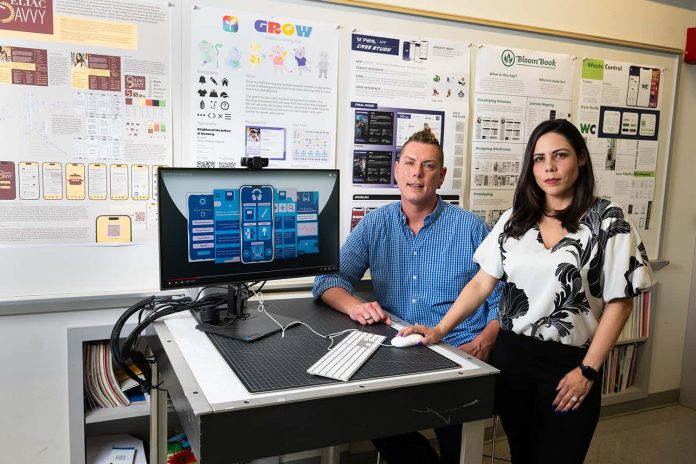Southern has launched a master’s program in User Research (UX) and User Interface (UI) Design, the first of its kind in New England, offering students an innovative curriculum to evolve their career paths.
The program’s emphasis on a user-centered design approach ensures that students are equipped to create intuitive, accessible, and aesthetically pleasing digital products such as websites, mobile apps, or web applications that people engage with through screens via phones, computers, and tablets.
A key emphasis of the new master’s program is learning not just technical skills, but the thinking and process behind them.
The core philosophy: design goes beyond technology.
Melanie Uribe, assistant professor of graphic design, led the development of the program and wrote most of the courses. “As the author of the program’s curriculum,” she said, “my goal was to create a graduate experience that empowers students to lead in a digital world, where design isn’t just about aesthetics, but about impact, inclusivity, and shaping how people interact with technology.”
“It’s thinking, human interaction,” said Alex Girard, associate professor of graphic design and chair of the Department of Art and Design, who collaborated with Uribe. “If we’re limited to teaching how technology works, as soon as that technology becomes obsolete, your skill set becomes obsolete. It’s not just about how to design X-Y-Z, but how to learn the skill set to design it. It’s technical evolution you can apply to your career regardless of the tool.”
The M.S. program is a result of years of planning. “The theme we recognized early on, UI and UX, went beyond a bullet point,” Girard said. “It has become a job title and a new career trajectory.”
Uribe agreed. “Design education should reflect the world we live in, diverse, user-focused, and constantly evolving,” she said. “This program is a response to that challenge: to prepare students with the creative and critical skills to thrive, and to open doors for voices often left out of the tech and design narrative.”
The visual and experience-focused design elements are a standout. The interdisciplinary, collaborative curriculum includes 21 core requirements and nine electives in areas like emerging tech, augmented reality, and accessibility.
The program reflects a triggered shift when the design industry started pivoting to more of a user experience format, Uribe said. Digital technology introduced products like virtual assistants, such as Amazon’s Alexa or Apple’s Siri, creating experiences that have become commonplace.
“It’s all about making everything user friendly. We still want to create a beautiful visual experience, but we also want to make sure the user has an enjoyable experience in whatever they do,” Uribe said.
Hands-on projects are central. Students will identify problems, research solutions, and design a prototype centered on user experience. Projects may span multiple semesters or shift focus, such as developing a tech-based game.
“Eventually, they’ll have created a full app designed so that people can use and test it,” Uribe said. “They’ll do a presentation, pitch it, test it for feedback.”
The program prepares students for roles across industries—from healthcare and finance to gaming and media. Career paths include UX researchers, accessibility specialists, interface designers, and consultants. Graduates may pursue jobs with top companies like Apple, Google, and Microsoft.
“There are so many possibilities!” Uribe said.
Valuable networking opportunities are built into the curriculum. Guest speakers, professional development days, and class visits to industry headquarters will provide students with exposure to real-world operations and potential career experiences. Through professional connections of Southern’s faculty members, the program already has plans to visit PepsiCo., NBC Universal, ESPN, and Lego.
As design professionals, Uribe and Girard are enthusiastic about the intersection of art and technology. That passion is embedded in the program—designed for students, alumni, and professional looking to stay marketable in a fast-changing digital landscape.
Applications are open for fall 2025 enrollment.


